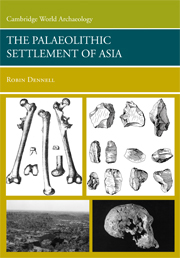Book contents
- Frontmatter
- Contents
- List of Tables, Figures, and Boxes
- Preface
- 1 Asia and Its Place in Palaeoanthropology
- 2 The African Background to the Colonisation of Asia
- 3 The Climatic and Environmental Background to Hominin Settlement in Asia before 1 MA
- 4 The Earliest Inhabitants of Southwest Asia
- 5 The Earliest Inhabitants of South and Southeast Asia and China
- 6 “Out of Africa 1” Reconsidered and the Earliest Colonisation of Asia
- 7 The Climatic and Environmental Background to Hominin Settlement in Asia between ca. 1 Ma and the Last Interglacial
- 8 The Middle Pleistocene Archaeological Record for Southwest and Central Asia
- 9 The Middle Pleistocene Archaeological Record of the Indian Subcontinent
- 10 The Middle Pleistocene Archaeological Record of China and Southeast Asia
- 11 Human Evolution in Asia during the Middle Pleistocene
- 12 Concluding Remarks
- Appendix 1 The Sizes of Countries and Regions in Asia, with Comparative Examples
- Appendix 2 Geographical Coordinates of Principal Early Palaeolithic Sites in Asia
- Appendix 3 Geographical Coordinates of Geological Sections and Cores
- Appendix 4 English Names of Various Mammals Recorded in Asia
- Bibliography
- Index
1 - Asia and Its Place in Palaeoanthropology
Published online by Cambridge University Press: 05 June 2012
- Frontmatter
- Contents
- List of Tables, Figures, and Boxes
- Preface
- 1 Asia and Its Place in Palaeoanthropology
- 2 The African Background to the Colonisation of Asia
- 3 The Climatic and Environmental Background to Hominin Settlement in Asia before 1 MA
- 4 The Earliest Inhabitants of Southwest Asia
- 5 The Earliest Inhabitants of South and Southeast Asia and China
- 6 “Out of Africa 1” Reconsidered and the Earliest Colonisation of Asia
- 7 The Climatic and Environmental Background to Hominin Settlement in Asia between ca. 1 Ma and the Last Interglacial
- 8 The Middle Pleistocene Archaeological Record for Southwest and Central Asia
- 9 The Middle Pleistocene Archaeological Record of the Indian Subcontinent
- 10 The Middle Pleistocene Archaeological Record of China and Southeast Asia
- 11 Human Evolution in Asia during the Middle Pleistocene
- 12 Concluding Remarks
- Appendix 1 The Sizes of Countries and Regions in Asia, with Comparative Examples
- Appendix 2 Geographical Coordinates of Principal Early Palaeolithic Sites in Asia
- Appendix 3 Geographical Coordinates of Geological Sections and Cores
- Appendix 4 English Names of Various Mammals Recorded in Asia
- Bibliography
- Index
Summary
INTRODUCTION
It is easy for someone accustomed to the small-scale landscapes of Europe to be mesmerised by the immensity, grandeur, and extremes of Asia. It is the largest continent, covering 17 million square miles, or an area larger than Africa and Europe combined. It has the fifty-six highest mountains in the world, but also the two lowest places on the earth's surface: the Dead Sea (−405 m) and the Turfan Depression, North China (−154 m). Tibet, with an average altitude of 5,000 m and an area half that of the United States, is the world's highest and largest plateau, and also has the world's deepest valleys, such as the 5-km-deep Yarlung Zangbo. The Caspian Sea, one-and-a-half times the size of Britain, is the world's largest inland sea, and Lake Baikal is the world's oldest, deepest, and largest (by volume) lake, with one-fifth of the world's fresh water (Chapter 3). Asia contains six of the ten longest rivers in the world, and most of those with the largest sediment discharge. Cherrapunji in Northeast India, where a ridiculous 26,461 mm (86.75 feet) of rain fell in 1860–61, including 9,300 mm (30 feet) in one month (Guinness World Records 2004:68), qualifies as the wettest place ever recorded, yet several of Asia's deserts – such as the Rub⼹al Khali of Arabia and the Taklamakan of North China – are among the most arid and hottest parts of the world.
- Type
- Chapter
- Information
- The Palaeolithic Settlement of Asia , pp. 1 - 8Publisher: Cambridge University PressPrint publication year: 2008



